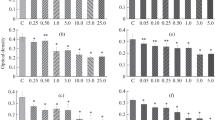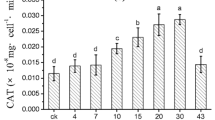Abstract
Extracts from the unicellular green alga Selenastrum capricornutum exhibit high superoxide dismutase activity, but only traces of catalase activity. The excess hydrogen peroxide (HO) generated by the superoxide dismutase in S. capricornutum may be degraded by a unique peroxidase. This peroxidase has a high specificity for ascorbate as its electron donor. The enzyme has an optimum pH at 8, is insensitive to cyanide and is inhibited by oxine. Addition of low concentrations of copper to algal cultures stimulates the peroxidase activity threefold. This enzymatic system could be used as a sensitive bioindicator for copper in fresh water.
Similar content being viewed by others
References
Asada K, Takahashi M. 1987 Production and scavenging of active oxygen in photosynthesis. In: Kyle DJ, Osmond CB, Antzen CJ, eds. Photoinhibition. Amsterdam: Elsevier Press; 227–287.
ASTM 1990 Standard guide for conducting static 96-well toxicity tests with microalgae. In: Annual Book of ASTM Standards. Philadelphia: American Society for Testing and Material, E 1218–90.
Beauchamp C, Fridovich I. 1971 Superoxide dismutase: improved assays and an assay applicable to acrylamide gel. Anal Biochem 44, 276.
Beers R, Sizer I. 1952 A spectrophotometric method for measuring the breakdown of hydrogen peroxide by catalase. J Biol Chem 195, 133.
Cheng GX, Asada K. 1989 Ascorbate peroxidase in tea leaves: occurrence of two isoenzymes and the differences in their enzymatic and molecular properties. Plant Cell Physiol 30, 987.
Gaspar T, Penel C, Thorpe T, et al.1982 Peroxidases: A Survey of their Biochemical and Physiological Roles in Higher Plants. Geneva: University of Geneva Press; 3–11.
Goudey JS. 1987 Modeling the inhibitory effects of metals on phytoplankton growth. Aquatic Toxicol 10, 265.
James DE. 1978 Culturing Algae. Burington, North Carolina: Carolina Biological Supply Co. Publication; 6–8.
Lee KC, Cunningham BA, Paulsen GM, et al.1976 Effects of cadmium on respiration rate and activities of several enzymes in soybean seedlings. Physiol Plant 36, 4.
Little C, Olinescu R, Reid KG, et al.1970 Properties and regulation of glutathione peroxidase. J Biol Chem 245, 3632.
Miller WE, Greene JC, Shiroyama T. 1978 The Selenastrum capricornutumPrintz algal assay bottle test: Experimental design, application, and data interpretation protocol. U.S. Environmental Protection Agency Report. EPA-600/9-78-018.
Miyake C, Michihata F, Asada K. 1991 Scavenging of hydrogen peroxide in prokaryotic and eukaryotic algae: acquisition of ascorbate peroxidase during the evolution of cyanobacteria. Plant Cell Physiol 32, 33.
Morgan PW, Joham HE, Amin JV. 1966 Effect of manganese toxicity on the indoleacetic acid oxidase system of cotton. Plant Physiol 41, 718.
Odum EP. 1971 Fundamentals of Ecology. Philadelphia: Saunders Press; 8–33.
Parrish PR. 1985 Acute toxicity tests. In: Rand GM, Petrocelli SR, eds. Fundamentals of Aquatic Toxicology. New York: Hemisphere Press; 31–57.
Shigeoka S, Nakano Y, Kitaoka S. 1980 Metabolism of hydrogen peroxide in Euglena gracilisz by L-ascorbic acid peroxidase. Biochem J 186, 377.
Tel-Or E, Huflejit M, Packer L. 1986 Hydrogen peroxide metabolism in cyanobacteria. Arch Biochem Biophys 246, 396.
Thompson PA, Courture P. 1991 Short and long-term changes in growth and biochemical composition of Selenastrum capricornutumpopulations exposed to cadmium. Aquatic Toxic 21, 135.
Welcher FL, Boschmann E. 1979 Organic Reagents for Copper. Huntington: Robert E. Kreiger Press; 68–70.
Author information
Authors and Affiliations
Corresponding author
Rights and permissions
About this article
Cite this article
Sauser, K.R., Liu, J. & Wong, TY. Identification of a copper-sensitive ascorbate peroxidase in the unicellular green alga Selenastrum capricornutum. Biometals 10, 163–168 (1997). https://doi.org/10.1023/A:1018343526264
Issue Date:
DOI: https://doi.org/10.1023/A:1018343526264




